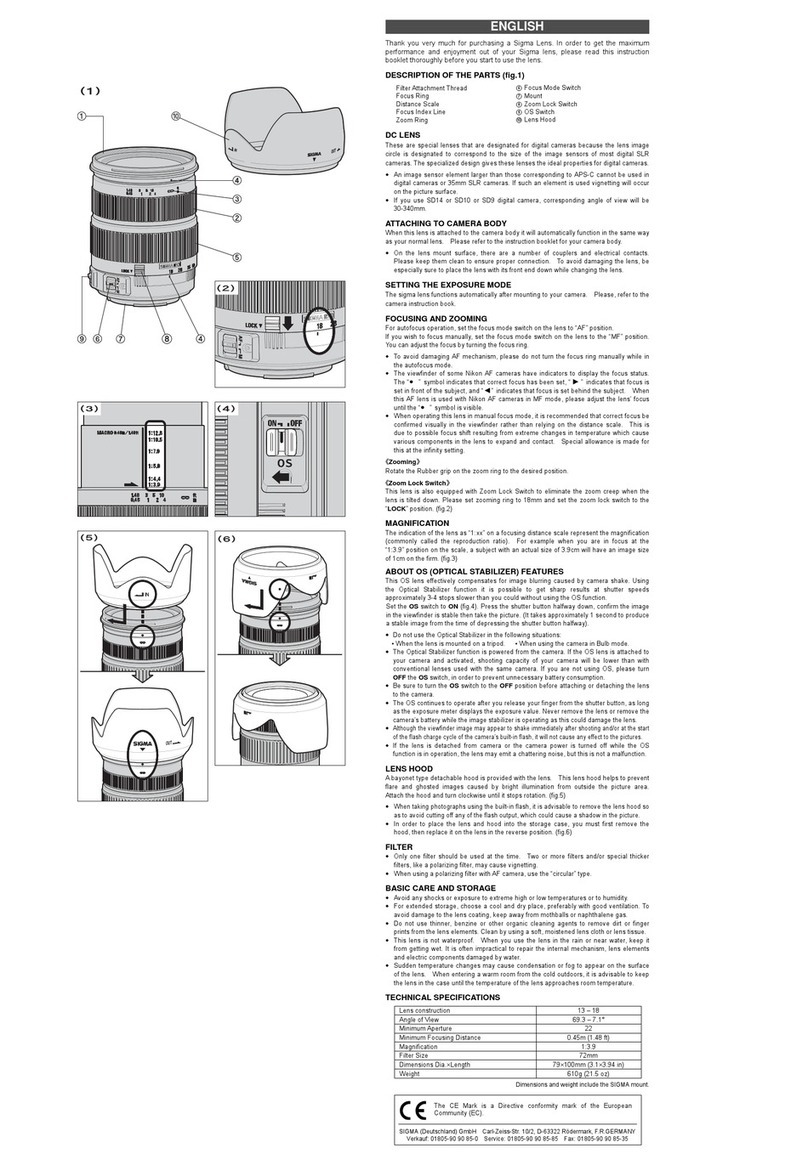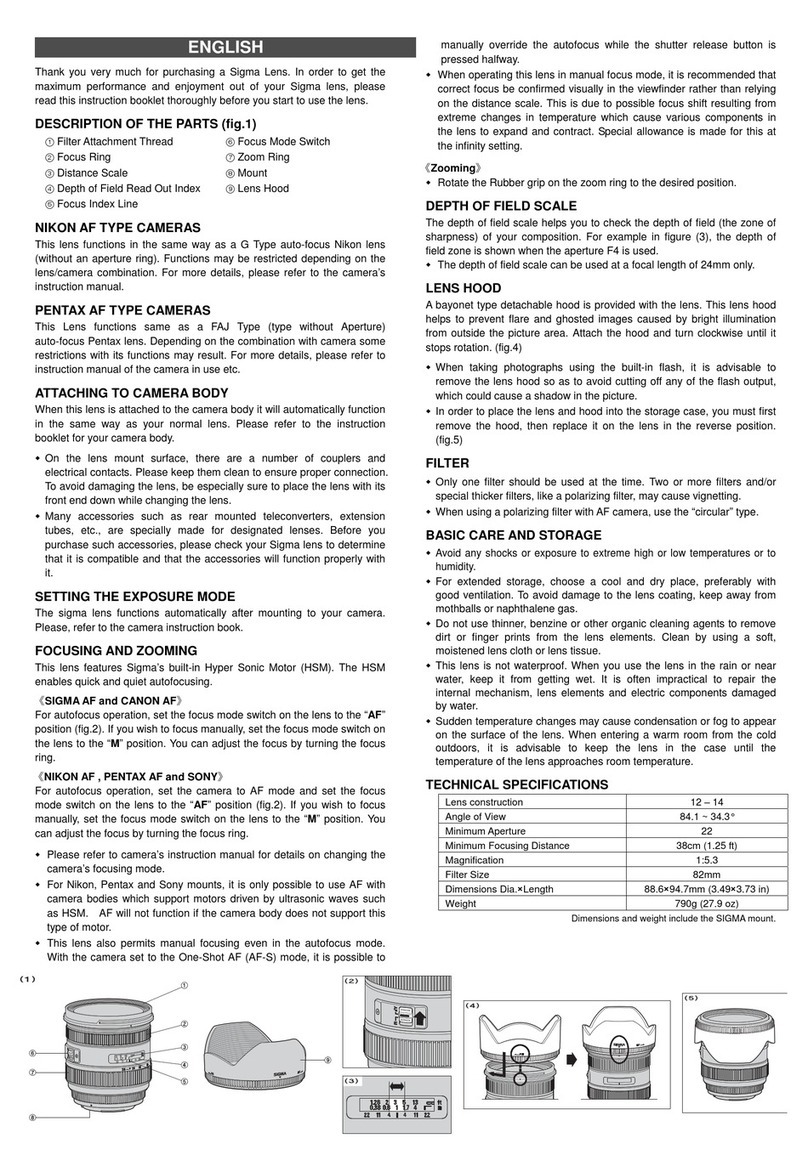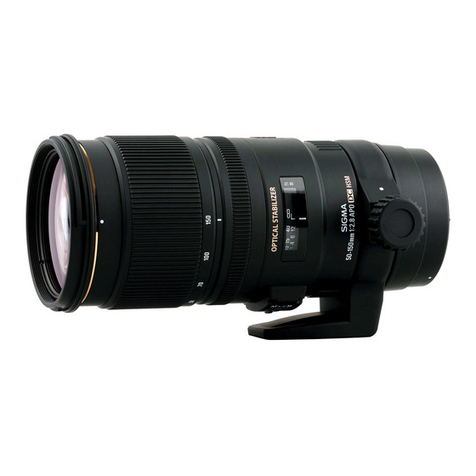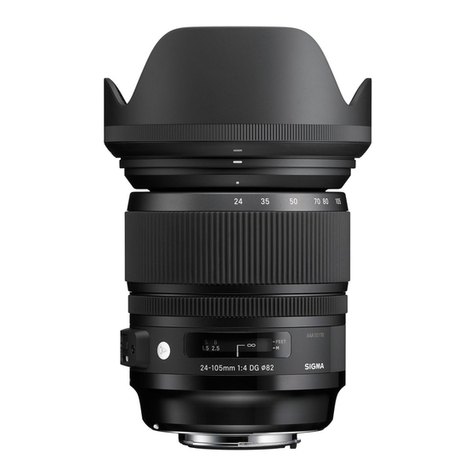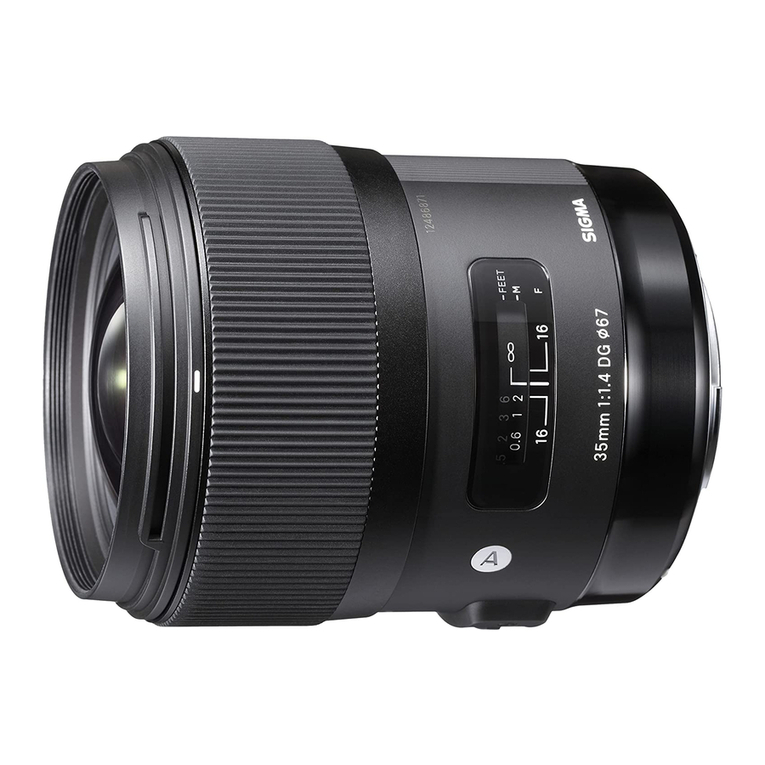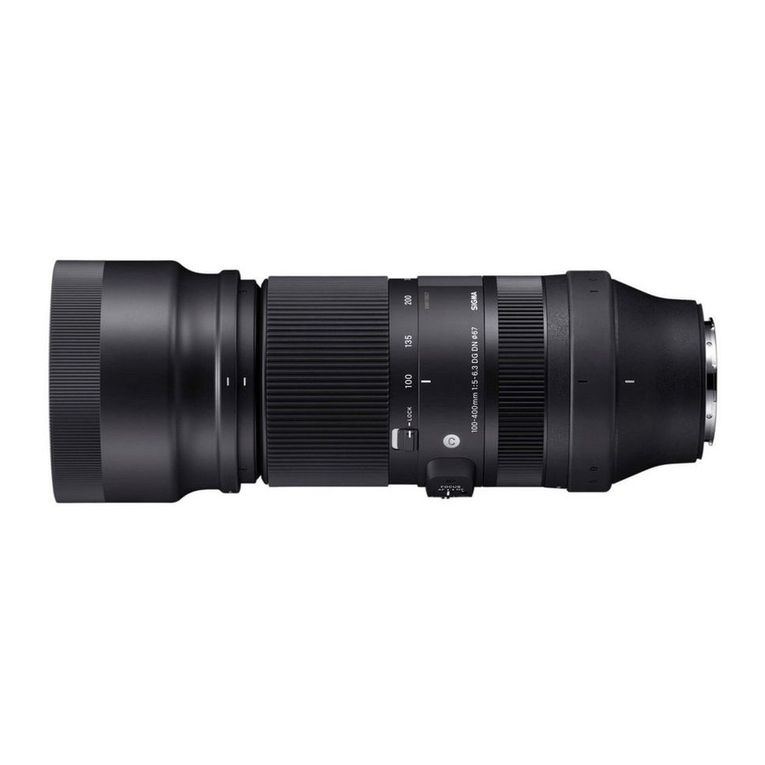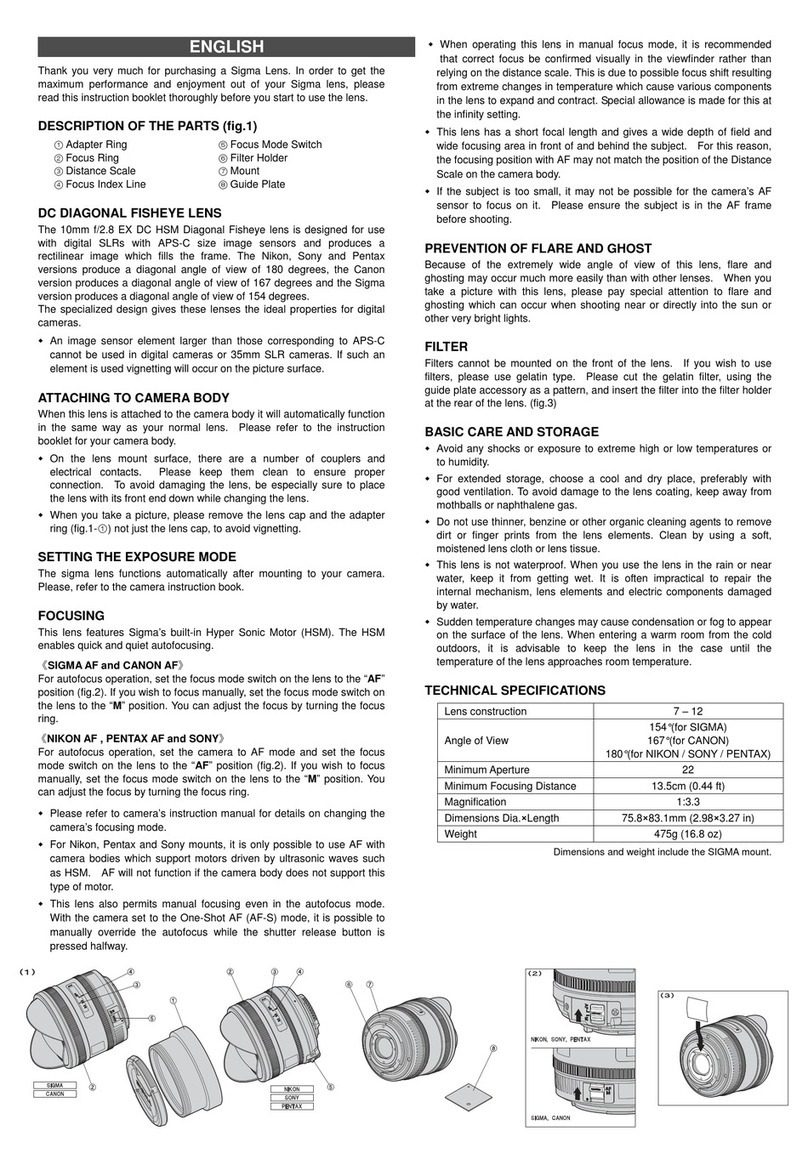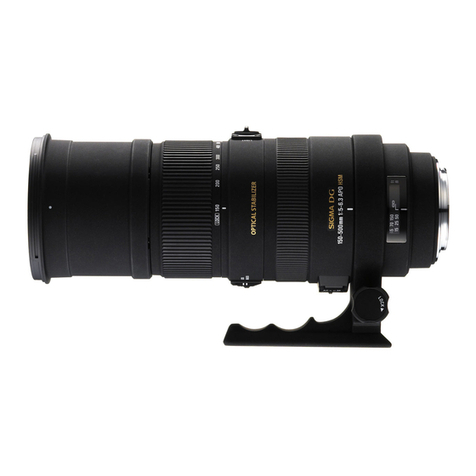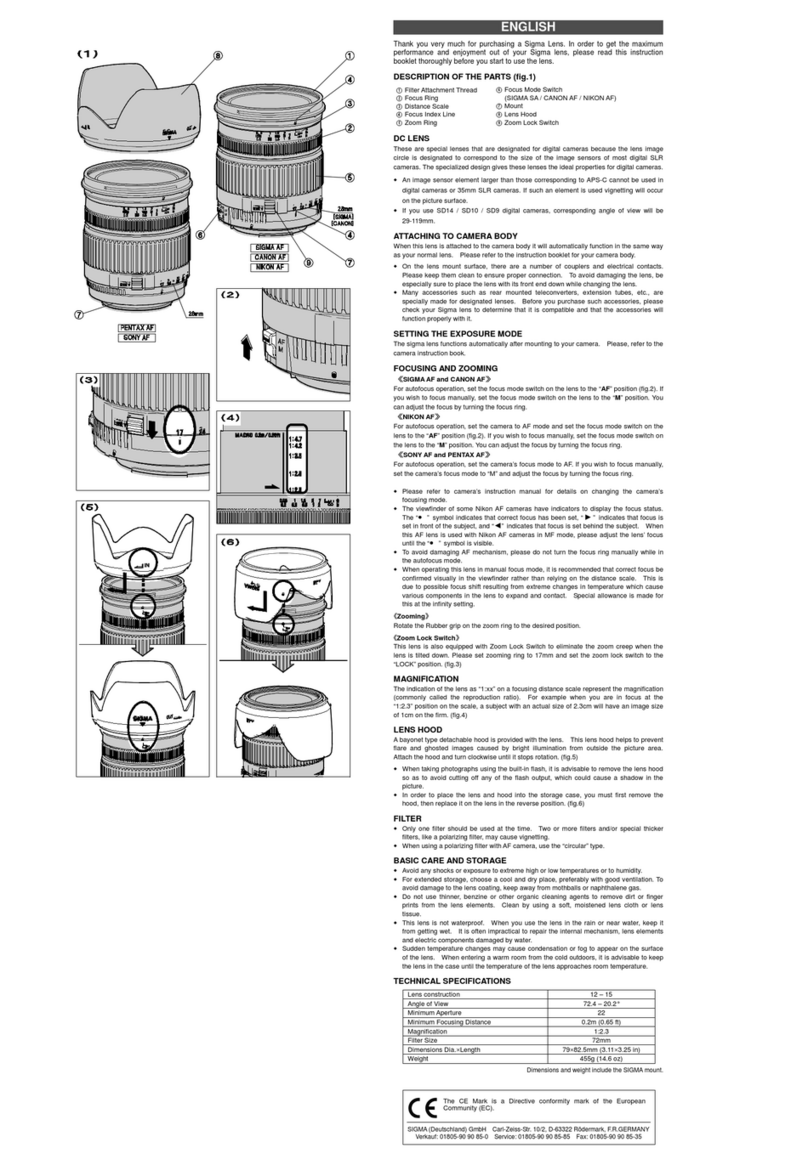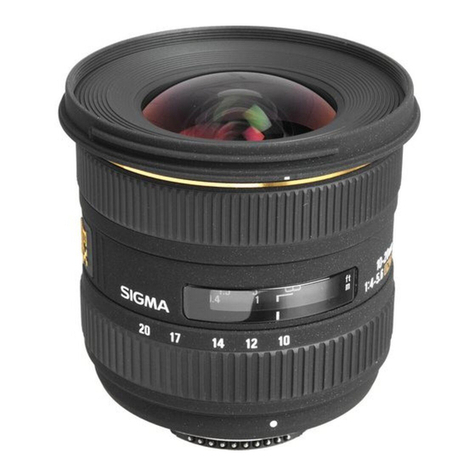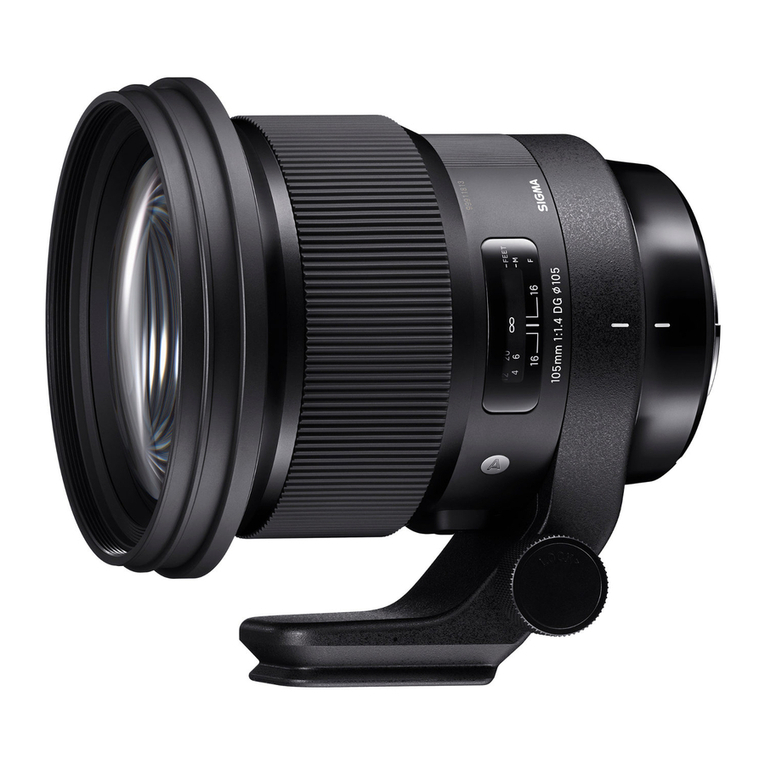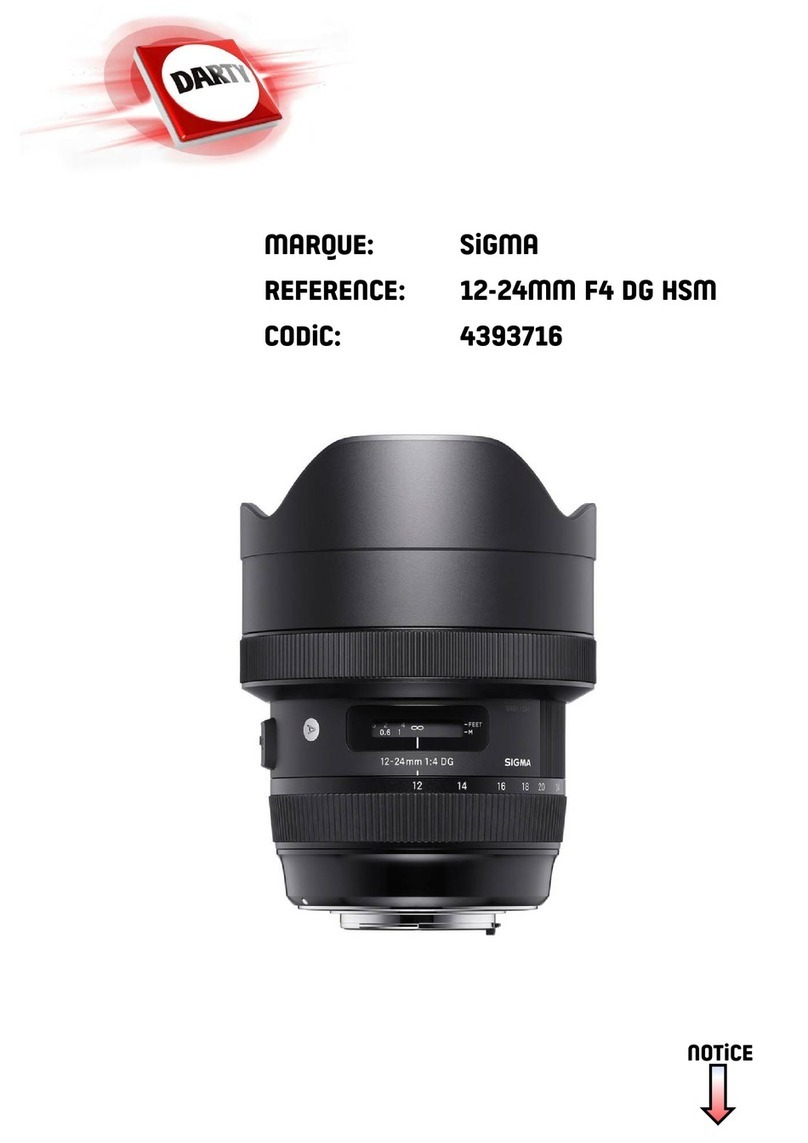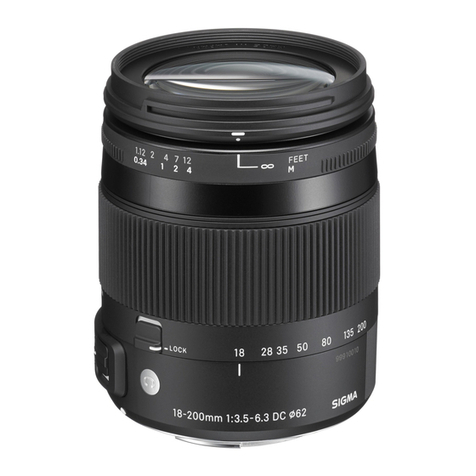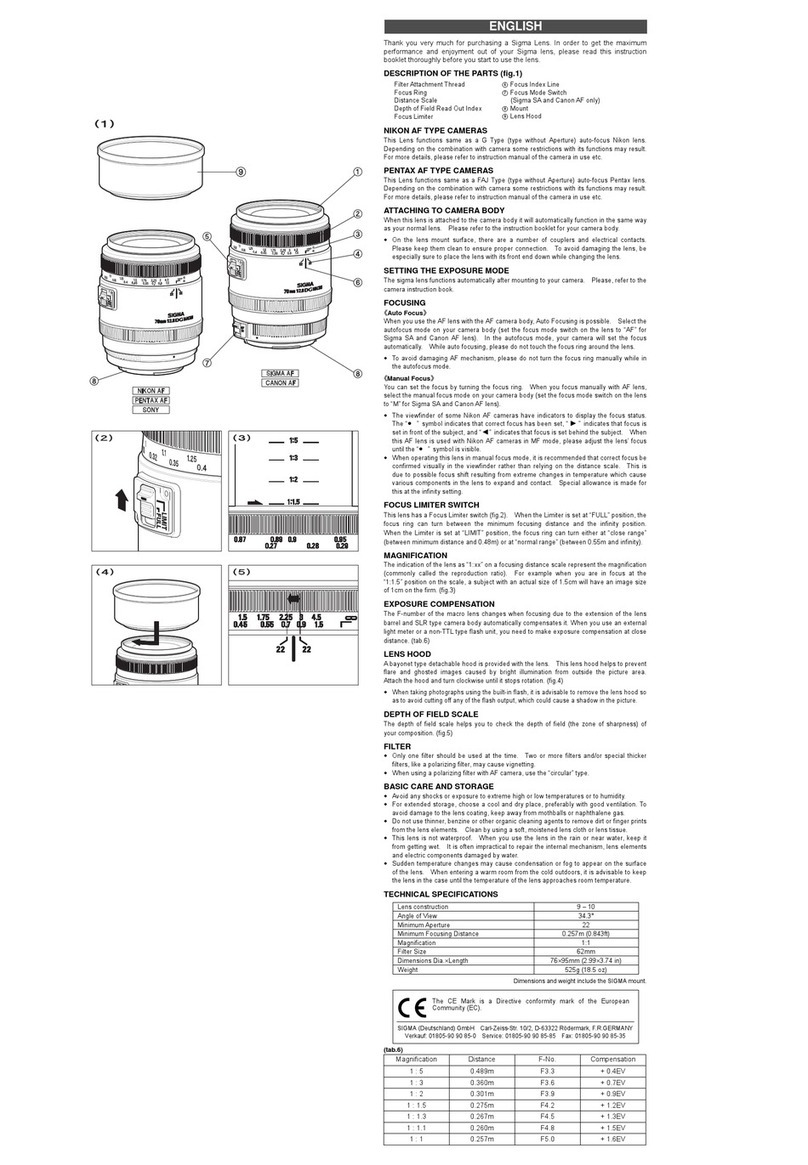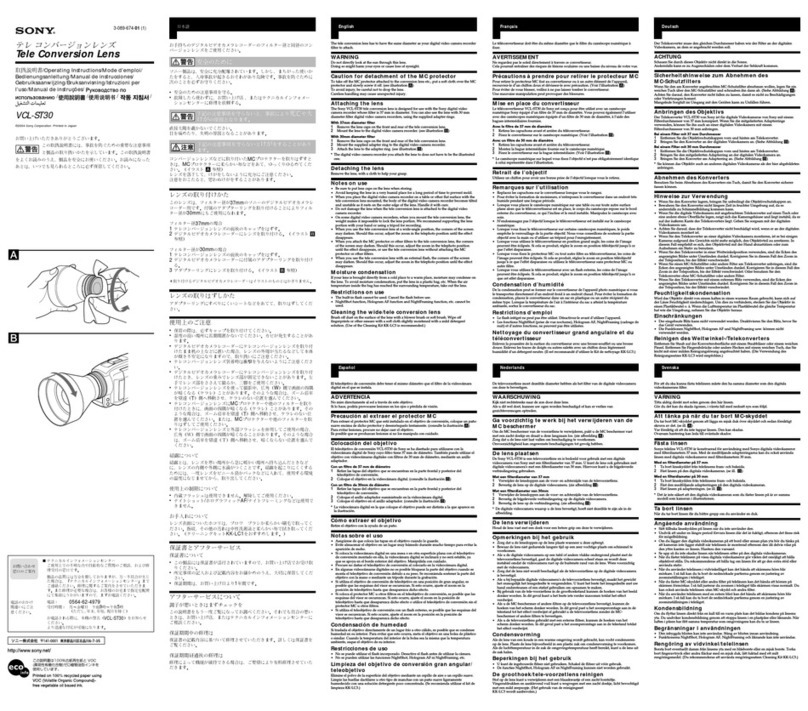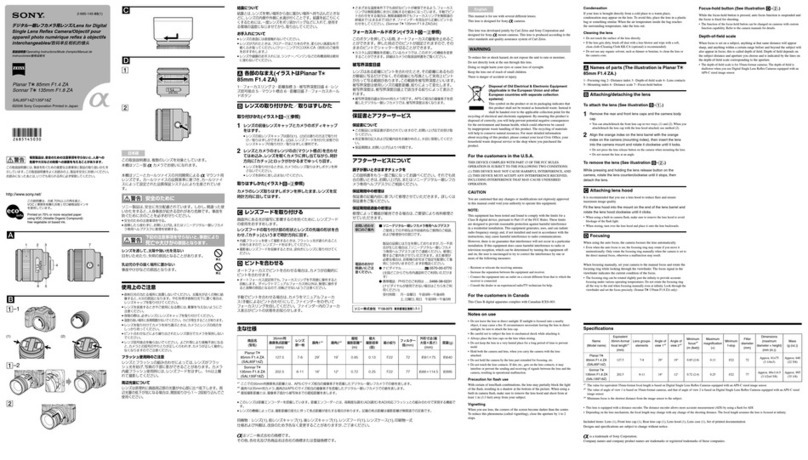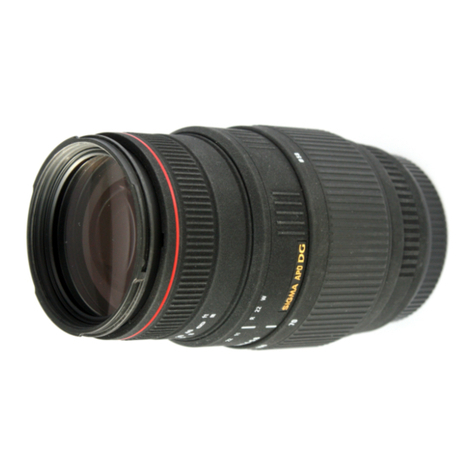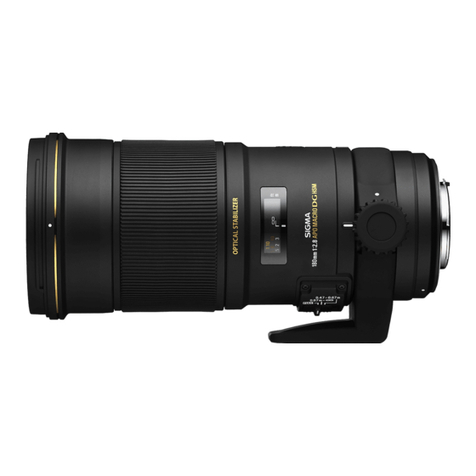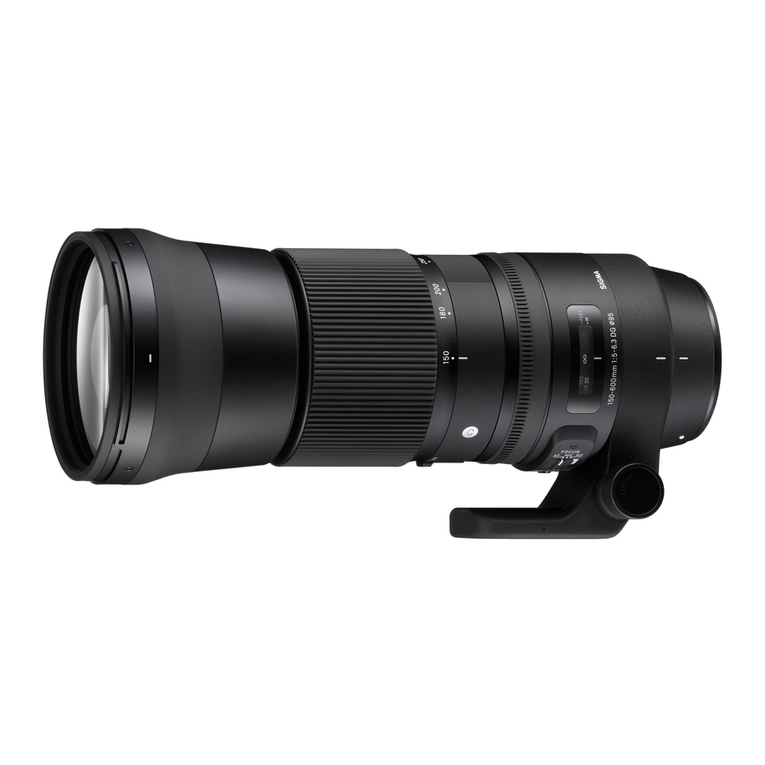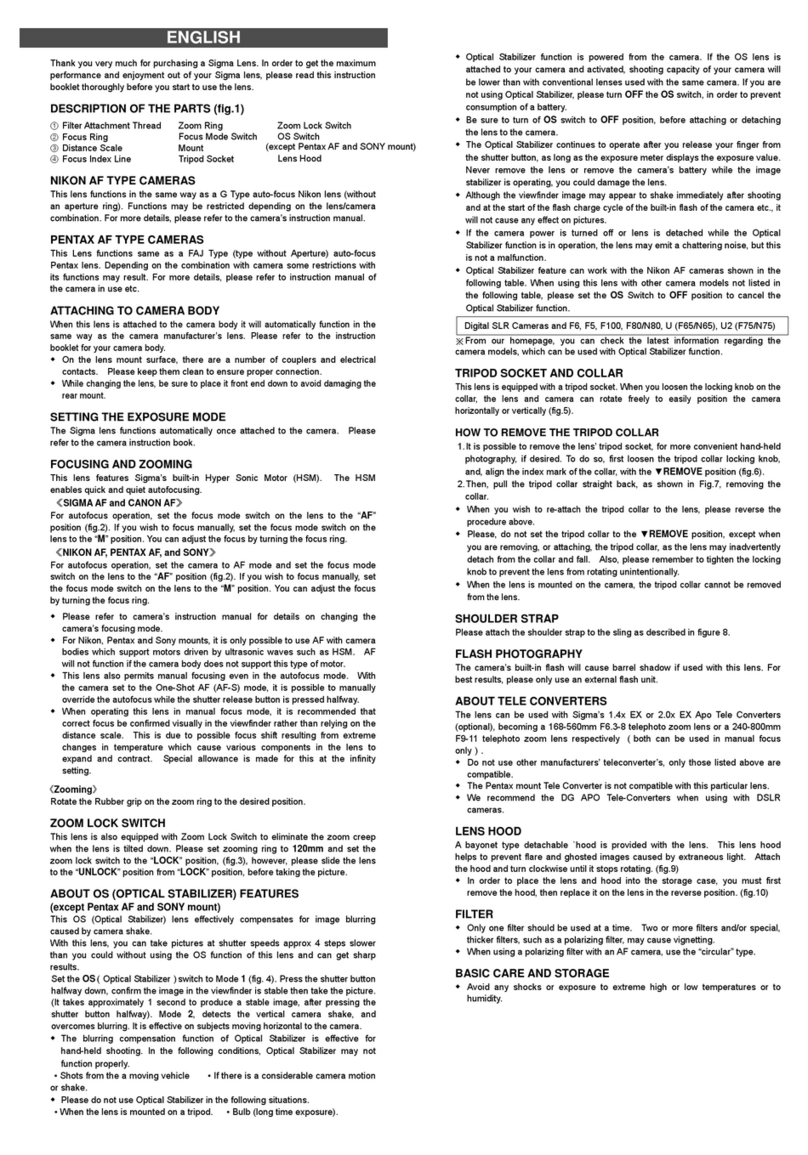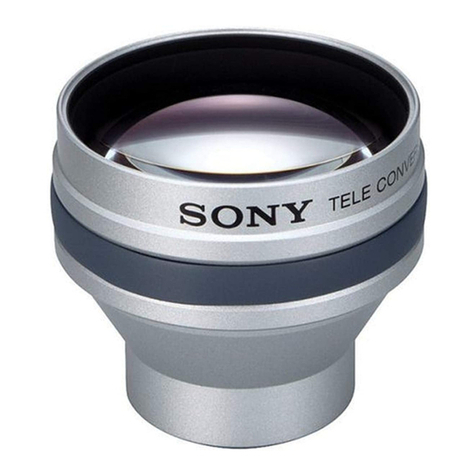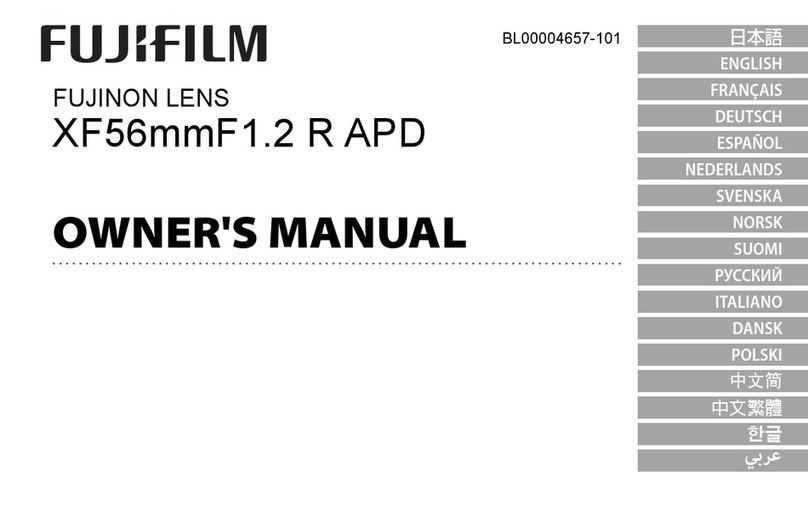Thank you very much for purchasing a Sigma Lens. In order to get the
maximum performance and enjoyment out of your Sigma lens, please read
this instruction booklet thoroughly before you start to use the lens.
DESCRIPTION OF THE PARTS (fig.1)
NIKON AF TYPE CAMERAS
This lens functions in the same way as a G Type auto-focus Nikon lens
(without an aperture ring). Functions may be restricted depending on the
lens/camera combination. For more details, please refer to the camera’s
instruction manual.
PENTAX AF TYPE CAMERAS
This Lens functions same as a FAJ Type (type without Aperture) auto-focus
Pentax lens. Depending on the combination with camera some restrictions
with its functions may result. For more details, please refer to instruction
manual of the camera in use etc.
ATTACHING TO CAMERA BODY
When this lens is attached to the camera body it will automatically function in the
same way as the camera manufacturer’s lens. Please refer to the instruction
booklet for your camera body.
◆ On the lens mount surface, there are a number of couplers and electrical
contacts. Please keep them clean to ensure proper connection.
◆
While changing the lens, be sure to place it front end down to avoid damaging
the rear mount.
SETTING THE EXPOSURE MODE
The Sigma lens functions automatically once attached to the camera. Please
refer to the camera instruction book.
FOCUSING AND ZOOMING
This lens features Sigma’s built-in Hyper Sonic Motor (HSM). The HSM
enables quick and quiet autofocusing.
《
SIGMA AF and CANON AF
》
For autofocus operation, set the focus mode switch on the lens to the “AF”
position (fig.2). If you wish to focus manually, set the focus mode switch on the
lens to the “M” position. You can adjust the focus by turning the focus ring.
《
NIKON AF, PENTAX AF, and SONY
》
For autofocus operation, set the camera to AF mode and set the focus mode
switch on the lens to the “AF” position (fig.2). If you wish to focus manually, set
the focus mode switch on the lens to the “M” position. You can adjust the focus
by turning the focus ring.
◆ Please refer to camera’s instruction manual for details on changing the
camera’s focusing mode.
◆ For Nikon, Pentax and Sony mounts, it is only possible to use AF with
camera bodies which support motors driven by ultrasonic waves such as
HSM. AF will not function if the camera body does not support this type of
motor.
◆ This lens also permits manual focusing even in the autofocus mode. With
the camera set to the One-Shot AF (AF-S) mode, it is possible to manually
override the autofocus while the shutter release button is pressed halfway.
◆ When operating this lens in manual focus mode, it is recommended that
correct focus be confirmed visually in the viewfinder rather than relying on
the distance scale. This is due to possible focus shift resulting from
extreme changes in temperature which cause various components in the
lens to expand and contract. Special allowance is made for this at the
infinity setting.
《Zooming》
Rotate the Rubber grip on the zoom ring to the desired position.
ZOOM LOCK SWITCH
This lens is also equipped with Zoom Lock Switch to eliminate the zoom creep
when the lens is tilted down. Please set zooming ring to 150mm and set the
zoom lock switch to the “LOCK” position, (fig.3), however, please slide the
lens to the “UNLOCK” position from “LOCK” position, before taking the
picture.
ABOUT OS (OPTICAL STABILIZER) FEATURES
(except Pentax AF and SONY mount)
This OS
(Optical Stabilizer)
lens effectively compensates for image blurring
caused by camera shake.
With this lens, you can take pictures at shutter speeds approx 4 steps slower
than you could without using the OS function of this lens and can get sharp
results.
Set the OS(Optical Stabilizer)switch to Mode 1 (fig. 4). Press the shutter
button halfway down, confirm the image in the viewfinder is stable then take
the picture.
(It takes approximately 1 second to produce a stable image, after
pressing the shutter button halfway). Mode
2
, detects the vertical camera
shake, and overcomes blurring. It is effective on subjects moving horizontal to
the camera.
◆ The blurring compensation function of Optical Stabilizer is effective for
hand-held shooting. In the following conditions, Optical Stabilizer may not
function properly.
▪Shots from the a moving vehicle ▪If there is a considerable camera
motion or shake.
◆ Please do not use Optical Stabilizer in the following situations.
▪When the lens is mounted on a tripod. ▪Bulb (long time exposure).
◆ Optical Stabilizer function is powered from the camera. If the OS lens is
attached to your camera and activated, shooting capacity of your camera
will be lower than with conventional lenses used with the same camera. If
you are not using Optical Stabilizer, please turn OFF the OS switch, in order
to prevent consumption of a battery.
◆ Be sure to turn of OS switch to OFF position, before attaching or detaching
the lens to the camera.
◆ The Optical Stabilizer continues to operate after you release your finger
from the shutter button, as long as the exposure meter displays the
exposure value. Never remove the lens or remove the camera’s battery
while the image stabilizer is operating, you could damage the lens.
◆
Although the viewfinder image may appear to shake immediately after
shooting and at the start of the flash charge cycle of the built-in flash of the
camera etc., it will not cause any effect on pictures.
◆ If the camera power is turned off or lens is detached while the Optical
Stabilizer function is in operation, the lens may emit a chattering noise, but
this is not a malfunction.
◆ Optical Stabilizer feature can work with the Nikon AF cameras shown in the
following table. When using this lens with other camera models not listed in
the following table, please set the OS Switch to OFF position to cancel the
Optical Stabilizer function.
Digital SLR Cameras and F6, F5, F100, F80/N80, U (F65/N65), U2
※From our homepage, you can check the latest information regarding the
camera models, which can be used with Optical Stabilizer function.
TRIPOD SOCKET AND COLLAR
This lens is equipped with a tripod socket. When you loosen the locking knob on
the collar, the lens and camera can rotate freely to easily position the camera
horizontally or vertically (fig.5).
HOW TO REMOVE THE TRIPOD COLLAR
1.It is possible to remove the lens’ tripod socket, for more convenient
hand-held photography, if desired. To do so, first loosen the tripod collar
locking knob, and, align the index mark of the collar, with the ▼REMOVE
position (fig.6).
2.Then, pull the tripod collar straight back, as shown in Fig.7, removing the
collar.
◆
When you wish to re-attach the tripod collar to the lens, please reverse the
procedure above.
◆ Please, do not set the tripod collar to the ▼REMOVE position, except when
you are removing, or attaching, the tripod collar, as the lens may
inadvertently detach from the collar and fall. Also, please remember to
tighten the locking knob to prevent the lens from rotating unintentionally.
◆
When the lens is mounted on the camera, the tripod collar cannot be removed
from the lens.
SHOULDER STRAP
Please attach the shoulder strap to the sling as described in figure 8.
FLASH PHOTOGRAPHY
The camera’s built-in flash will cause barrel shadow if used with this lens. For
best results, please only use an external flash unit.
ABOUT TELE CONVERTERS
The lens can be used with Sigma’s 1.4x EX or 2.0x EX Apo Tele Converters
(optional), becoming a 210-700mm F7-9 telephoto zoom lens or a
300-1000mm F10-13 telephoto zoom lens respectively (both can be used in
manual focus only).
◆ Do not use other manufacturers’ teleconverter’s, only those listed above are
compatible.
◆ The Pentax mount Tele Converter is not compatible with this particular lens.
◆ We recommend the DG APO Tele-Converters when using with DSLR
cameras.
LENS HOOD
A bayonet type detachable `hood is provided with the lens. This lens hood
helps to prevent flare and ghosted images caused by extraneous light.
Attach the hood and turn clockwise until it stops rotating. (fig.9)
ENGLISH
Zoom Lock Switch
OS Switch
(except Pentax AF and SONY mount)
Lens Hood
① Filter Attachment Thread
② Focus Ring
③ Distance Scale
④ Focus Index Line
Zoom Ring
Focus Mode Switch
Mount
Tripod Socket
